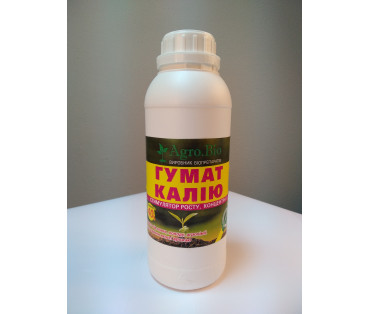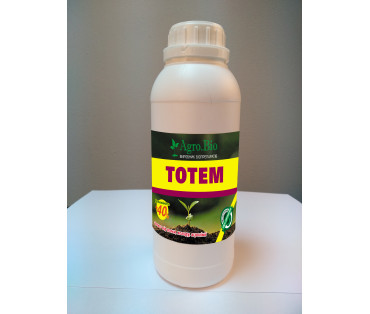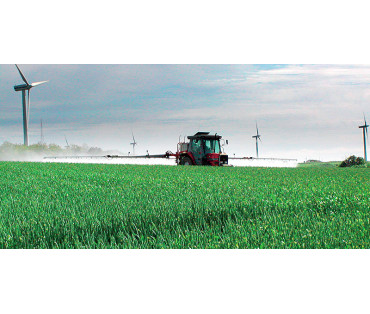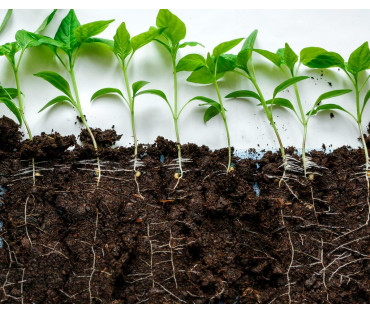Influence of Totem Agro.Bio on the development of grape seedlings
Agro.Bio pays great attention to the further development of viticulture.
To successfully solve the problems of developing viticulture, it is of great importance to increase the yield of first-class seedlings.
The output of seedlings from the school is still quite low, which to a large extent delays the expansion of areas under vine plantations. A particularly low yield of seedlings is obtained from quarantine nurseries located on the sands in Ukraine.
The works of L. A. Khristeva established that humic acids cause strong growth and development of plants. It was noted that the action of these acids is especially noticeable when applied at the beginning of plant development and when transplanting seedlings, when the root system is injured.
L. V. Kolesnik, Doctor of Biological Sciences, points out that under the influence of humic acid, the process of callus formation on sections of the rootstock and scion is significantly enhanced, the fusion of the scion with the rootstock and the root formation of the rootstock are improved.
Humic acid, introduced during the stratification of grafts and their hardening, also contributes to the intensive growth of roots in shkolka.
All this prompted a series of studies to study the effect of Totem Agro.Bio and potassium humate on the development of grape seedlings when grown in a school on the sands.
The work was carried out in a quarantine nursery on the sands of the Ukrainian Research Station of Viticulture and Sand Development. The soil is deep single-phase sand. According to prof. Sobolev, it consists of 98% quartz. The amount of humus reaches 0.1%. These soils have high water permeability and low absorption capacity, and therefore there is a washout of nutrients deep into the soil. The sands are very loose and have very little cohesion, which causes such harmful phenomena as sand mobility, blowing, falling asleep and notching crops. Soils of this type are extremely poor in the mineral nutrition of plants.
The test of the effect of humic fertilizers on the growth and development of grape seedlings was carried out in 2019-2021. The present communication is devoted to the results of these works.
Objectives of the study and methodology for conducting experiments
It is known that the process of engraftment of cuttings is determined by the transformation of reserves of plastic substances. Therefore, the more actively the biochemical processes take place in the cuttings after they are planted in the school, the faster they will take root. Undoubtedly, these processes are inseparably linked with the intensity of the oxidative exchange. Since it is believed that Totem Agro.Bio is used by the plant to enhance the phenolase oxidative system, there is reason to believe that the soaking of grape cuttings in the Totem Agro.Bio solution should activate the biochemical processes occurring in them and help increase the survival rate, increase the growth and development of grape seedlings.
Based on this, experiments were carried out for 3 years to study the effect of soaking grape cuttings in the Totem Agro.Bio solution .
At the same time, the concentrations of Totem Agro.Bio and the soaking time were studied in connection with the pre-planting treatment of the cuttings.
Planting material, after appropriate pre-treatment, was planted in a shkolka in such a way that in each variant there were 1600 plants. The experiments were repeated four times.
In addition, a study was made of the effect of top dressing Totem Agro.Bio , which was introduced along with irrigation water. Contributed at a concentration of 0.002%. Irrigation rate for each irrigation is 250-300 m 3 In all cases when Totem Agro.Bio was applied with irrigation, the control plots were watered.
The agrotechnics of each experiment will be described in the presentation of the results. In the experiments of 2019 and 2020. the grape variety was Chasla white, in 2021 - Rkatsiteli.
Influence of different conditions of cuttings soaking in the Totem Agro.Bio solution on the development of seedlings in a school on the sands
Experiments to study this issue were launched in 2019. The cuttings were kept in product solutions before kilching, furrowing and planting for a different number of hours. After that, part of the cuttings was installed in trenches for kilching, the other was planted in a school. Kilchevanie was carried out in open trenches.
After opening the trench, it turned out that due to very low temperatures, callus formation on the cuttings did not occur in any of the options, and the cuttings, according to the experimental scheme, were planted in a school without callus. Observations in Table. one.
Table 1
The effect of soaking grape cuttings in Totem Agro.Bio
on the survival rate and the yield of seedlings from the school
(Based on 2019 experience)
|
Experience Scheme |
Basic fertilizer—N-60, R-90, K-30 |
||||
|
Survival in % |
Total YIELD in % |
||||
|
Preplant processing of cuttings |
Soak time in hours |
soaked in |
soaked in |
||
|
water |
Totem Agro.Bio |
water |
Totem Agro.Bio |
||
|
kilchevanie |
12 24 |
54 54 |
fifty 54 |
59 |
52 44 |
|
Furrowing |
12 |
24 |
67 |
fifteen |
55 |
|
24 |
38 |
45 |
27 |
43 |
|
|
No pre-treatment |
12 24 |
47 46 |
65 62 |
fifteen 35 |
55 38 |
Note. Care of seedlings in shkolka consisted of the following: 8 waterings were done, 2-fold feeding with ammonium nitrate at the rate of N-30 per application and RK at the rate of 30 kg P 2 O 5 and 20 kg K 2 O. Four-fold loosening of row spacings and mounds was carried out . A five-time spraying with a 1% solution of Bordeaux mixture was made.
The table shows that in all variants of the experiment there was an extremely low survival rate of cuttings and an extremely low yield of seedlings from the school.
The low output of seedlings from the shkolka was also affected by the fact that they were planted without callus.
From the experience, it turned out that the effect of Totem Agro.Bio was noticeable only when the cuttings were furrowed and when they were planted without pre-planting treatment.
The best results are obtained by soaking the cuttings in Totem Agro.Bio for 24 hours.
In 2020, the effect of soaking cuttings in Totem Agro.Bio was tested at various concentrations and for different periods. Soaking of the cuttings was carried out before kilching, which was carried out in ordinary trenches under greenhouse frames at higher temperatures than in 2019. After the opening of the trenches, callus formation on the cuttings was taken into account.
After taking into account the results of kilching, the cuttings were planted according to the scheme of the experiment in the school according to the backgrounds:
1. N 30 , P 90 , K 30 , into the furrows during planting;
2. N 60 in the furrows during planting and N 30 + N 30 R 30 K 30 in the form of dressings.
The results of this experience are presented in table. 2 .
table 2
Influence of soaking time and concentration of Totem Agro.Bio
on the development of grape seedlings in a school on the sands
(Based on 2020 experience)
|
Soaking time for cuttings in hours |
The cuttings are soaked |
Cuttings that did not form callus in % |
Background in school |
|||
|
N 30 +P 30 +K 30 |
N 30 +N 30 +P 30 ________ K 30 |
|||||
|
seedling output |
||||||
|
total in % |
1 grade In % |
total in % |
1 grade in % |
|||
|
24 |
In water
|
1.8
|
66
|
52
|
67 |
51 |
|
In Totem Agro.Bio |
|
|||||
|
0.002% |
1.4
|
77
|
57 |
79 |
63 |
|
|
0.003% |
1.4 |
85 |
66 |
86 |
70 |
|
|
0.004% |
3.4 |
83 |
47 |
81 |
61 |
|
|
48 |
In water
|
11.0 |
78 |
fifty |
76 |
60 |
|
In Totem Agro.Bio |
|
|||||
|
0.002% |
1.2 |
76 |
59 |
81 |
61 |
|
|
0.003% |
3.2 |
82 |
66 |
82 |
65 |
|
|
0.004% |
2.4 |
78 |
60 |
77 |
61 |
|
Note. The care of seedlings in shkolka was as follows: during the growing season, 12 irrigations were made, 4-fold loosening of row-spacings and mounds was done, 4-fold spraying with a 1% solution of Bordeaux mixture was carried out.
The table shows that soaking in Totem Agro.Bio significantly increased both the overall yield of seedlings and the yield of first grade seedlings. This influence of our product manifested itself approximately equally on both backgrounds. The best results were given by the concentration of Totem Agro.Bio 0.003%. The optimal time for soaking cuttings in Totem Agro.Bio can be considered 24 hours.
In 2021, experiments were again laid to study the concentration value of the Totem Agro.Bio solution , in which the cuttings were soaked.
Some of the cuttings were soaked before kilching, the other - immediately before landing in the school. Soaking time for cuttings of all options is 24 hours.
After kilchevaniya cuttings according to the scheme of the experiment were planted in the school on the background: P 60 in the furrows during planting and N 30 + N 30 P 30 K 30 in the form of top dressing.
The results of the experiment are presented in table. 3 .
Table 3
Influence of soaking grape cuttings in Totem Agro.Bio solution of various concentrations on the development of seedlings in a school on the sands
|
Pre-seating treatment |
Soaked cuttings |
Background : P 60 +N 3o +N 3o +P 30 K 30 |
||||||
|
survival rate in % |
total yield of seedlings in % |
yield of seedlings of the 1st grade in %__________ |
with height in cm |
mature growth in cm |
number of roots |
|||
|
on the heel |
on the 1st node |
|||||||
|
Kilchev- we |
In water |
78 |
85 |
80 |
62 |
32 |
7.8 |
2.9 |
|
In Totem Agro.Bio |
||||||||
|
0.002% |
83 |
94 |
91 |
65 |
35 |
8.7 |
4.2 |
|
|
0.003% |
85 |
90 |
84 |
67 |
35 |
7.7 |
4.2 |
|
|
Without keel honoring |
In water |
35 |
71 |
58 |
47 |
25 |
7.0 |
2.2 |
|
In Totem Agro.Bio |
||||||||
|
0.003% |
33 |
77 |
57 |
49 |
27 |
7.1 |
2.9 |
|
Note: The care of seedlings in shkolka was as follows: 5 irrigations were made at the rate of 250-300 m 3 of water per 1 ha, 3-fold loosening of row-spacings and mounds was carried out, 4-fold spraying with a 1% solution of Bordeaux mixture.
The data in the table shows that this year the soaking in Totem Agro.Bio had a positive effect. The total yield of seedlings from the shkolka increased, the yield of seedlings of the 1st grade increased, and, what is especially interesting, the number of roots on the heel and on the 1st node increased.
From this experience, it follows that Totem Agro.Bio accelerates the maturation of wood. This circumstance may affect the winter hardiness of seedlings during storage.
It is interesting to note that this year the influence of Totem Agro.Bio on callus formation was even more pronounced. Accounting after kilchevaniya showed that from cuttings soaked in water, callus formed 77%, from soaked in a 0.002% solution of Totem Agro.Bio - 88% and from soaked in a solution of 0.003% - 90%.
It should be said that this year, as in the past, the optimal concentration of Totem Agro.Bio for soaking cuttings was 0.002%-0.003%.
The same table shows that the process of kilchevaniya plays an extremely important role in the cultivation of seedlings: it increases their yield from nurseries.
The most effective was the combination of soaking the cuttings in Totem Agro.Bio with kilchevanie.
Efficiency of top dressings Totem Agro.Bio when growing
grape seedlings in schools on the sands
Experiences in 2020 and 2021 the influence of different terms of applying Totem Agro.Bio was studied when fertilizing grape seedlings in a school on the sands.
Top dressings of Totem Agro.Bio were made on shkolka plots. where cuttings were planted, soaked before kilching in Totem Agro.Bio solution on the same backgrounds as in previous experiments of the same years.
The results of the 2020 experience are given in Table. 4 , and 2021 - in table. 5 .
The data in the table show that top dressing with humic acid has a positive effect on the yield of seedlings from shkolki, especially the 1st grade.
Of the various periods of feeding Totem Agro.Bio , the most effective is the variant where this microfertilizer was given with each watering.
It should be noted that the combination of top dressing Totem Agro.Bio and soaking the cuttings before kilching gives the best results , increasing the total yield of seedlings against the control by 34% and the yield of seedlings of the 1st grade up to 40%. These options, obviously, should be recommended to production.
Table 4
Influence of feeding Totem Agro.Bio on the development of vine seedlings in a school on the sands
(Based on 2020 experience)
|
Soaked cuttings |
Experience Scheme |
__________ Background |
|||||
|
N 3o P 90 K 90 |
R 60 + +N 30 +N 30 +R 30 K 30 |
||||||
|
Seedling output |
Seedling output |
||||||
|
total in % |
1st grade in % |
total in % |
1st grade in % |
||||
|
In water In Totem Agro.Bio 0.002% |
Watering Same |
66 81.7 |
52 70.5 |
67 80 |
50.6 65.4 |
||
|
Watering with Totem Agro.Bio solution during planting |
82.7 |
63.7 |
1 84 |
67.6 |
|||
|
Totem Agro.Bio when roots appear |
83.0 |
62.5 |
1 81 |
67.2 |
|||
|
Totem Agro.Bio when the shoot reached 10 cm |
79.2 |
65.0 |
79.7 |
66.5 |
|||
|
When planting, when roots appear, when shoot 10 cm |
82.3 |
70.0 |
70.5 |
56.5 |
|||
|
During all waterings (12 times) |
87.8 |
74.4 |
83.3 |
67.6 |
|||
2 Note. Care of seedlings in shkolka was as follows: during the growing season, 12 irrigations were carried out at the rate of 250-300 m 3 of water. A 4-fold loosening of row-spacings and mounds was made, a 3-fold spraying with a 1% solution of Bordeaux mixture was carried out.
Table 5
Influence of feeding Totem Agro.Bio on the development of vine seedlings
in a school on the sands
(Based on 2021 experience)
|
The cuttings are soaked |
Experience Scheme |
Background—K 30 |
P 60 +N 30 +N 30 + P 30 |
||
|
seedling output |
gain in cm |
gain aging in cm |
|||
|
total in % |
1st grade in % |
||||
|
In water |
Without top dressing Totem Agro.Bio |
84 |
67 |
fifty |
31 |
|
In Totem Agro.Bio 0.003% |
Without top dressing Totem Agro.Bio |
88 |
78 |
52 |
31 |
Our feed: |
|||||
|
|
With Totem Agro.Bio - When roots appear |
90 |
81 |
51 |
31 |
|
|
When sprouting... |
94 |
84 |
fifty |
31 |
|
|
With a run of 10 cm ... |
92 |
84 |
52 |
32 |
|
|
When roots appear. at germination and shoot at 10 cm ... |
92 |
85 |
53 |
34 |
|
|
During all irrigations (Five times) |
93 |
83 |
47 |
29 |
Note. The care of seedlings in shkolka was as follows: during the growing season, 5 irrigations were carried out at the rate of 250-300 m calculation N 30 kg / ha and one top dressing, RK 30 kg of nutrients.
Table data . 5 show that in 2021 the combination of Totem Agro.Bio top dressing with cuttings soaking before kilching was also effective, although the relative increase in the total yield of seedlings was less than in the previous year. Obviously, this must be related to the fact that in 2021 the total number of top dressings of Totem Agro.Bio was 5 times, and in 2020 - 12 times. From this, it should be concluded that fertilizing with microfertilizers should be given more often than they were given in 2021. The cheapness of this drug makes it possible to do this.
For three years, potassium humate was also tested in the school, but it turned out to be less effective than Totem Agro.Bio .
Due to the fact that grapes still react positively to Totem Agro.Bio , there is reason to believe that if the alkaline properties of potassium humate change, in this case it can have a positive effect. This issue deserves further study.
CONCLUSIONS
Totem Agro.Bio , when grape cuttings are soaked in it before kilching, has a positive effect on the overall yield of seedlings. as well as for the output of seedlings of the 1st grade.
1. The best concentration of humic acid solution when soaking cuttings is: 3l/ha Totem Agro.Bio
2. Soaking cuttings in Totem Agro.Bio solution should be carried out within 24 hours.
3. When top dressing Totem Agro.Bio seedlings in a school on an organic background of fertilizers, the overall yield of seedlings, and especially the 1st grade, also increases.
4. Top dressing Totem Agro.Bio must be done with each watering from the moment the roots form.
Related Products
Humate Potassium + Phosphorus «Agro.Bio»
Potassium humate + ballast-free phosphorus from leonardite produced by AGRO.BIO is an environmentally friendly complex fertilizer and growth stimulator for agricultural plants, of organic origin, with..
$7.00
Totem «Agro.Bio»
Totem "Agro.Bio" is an organic stimulator and regulator of plant growth, which is an innovative drug of complex action with the effect of prolonging the youth of the plant. Totem "Agro.Bio" is an org..
$10.00
Related Articles
Influence of humates on plant resistance to the effects of adverse factors and stresses
The humates impact on sustainable plant development. Dependence of the humates effectiveness on the degree of plants development optimal conditions deviation The most important feature of humates..
Nitrogen (N) increases yields and is absorbed in the form of ammonia or nitric acid
Nitrogen (N) is one of the most important major nutrient element for the plant, which increases yields and is absorbed in the form of ammonia or nitric acid (only legumes have the ability to absorb at..
The influence of potassium humate Mind Extra and Amino Enegry Agro.bio on the wheat crop in the south of Ukraine
A characteristic feature of hard spring wheat is their high protein content, but in the south of Ukraine they yield a relatively lower yield than winter wheat. Therefore, it is extremely important to ..
Physiological principles of technology of humic preparations on the example of potassium humate
Based on a large number of works in the World (including L.A. Khristeva), it can be concluded that the use of humic preparations, which have been studied until recently, has a double meaning.On the on..
Effect of Humic and Fulvic Acids on Phosphorus Uptake in Plants Depending on Environmental Temperature
The stimulating effect of humic and fulvic acids on plants has been noted by various scientists, including specialists from the mineral fertilizer manufacturer Agro.Bio, but the ..







-370x314.jpg)